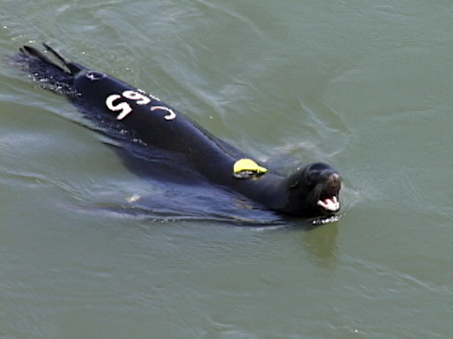forum
library
tutorial
contact

Seven More California Sea Lions Captured
Below Bonneville Dam, Four Euthanized
by Staff
Columbia Basin Bulletin, April 27, 2014
|
the film forum library tutorial contact |

|
Seven More California Sea Lions Captured
by Staff
|
 Of that total, three were on the list for removal -- having been observed at the dam on multiple occasions eating salmon and steelhead -- and were euthanized. Four were branded and released.
Of that total, three were on the list for removal -- having been observed at the dam on multiple occasions eating salmon and steelhead -- and were euthanized. Four were branded and released.
The effort, which began early this month, resulted in the capture of five California sea lions April 15, all of which were branded for future identification purposes and released. Six of the big animals had been trapped the previous day and euthanized.
(See CBB, April 18, 2014, "Spring Ritual: States Begin Trapping, Euthanizing Sea Lions Feasting On Chinook At Bonneville Dam")
In March 2012, NOAA Marine Fisheries issued a letter authorizing the states to remove specific California sea lions observed eating salmon and steelhead in the Columbia River. The pinnipeds' presence at the dam, and predation by identifiable animals, has been documented since 2002 by researchers charged with evaluating impacts on salmon and other fish. Five of the salmon and steelhead stocks passing the dam during the late winter late spring time period are listed under the Endangered Species Act.
The authorization stays in effect until June 1, 2016.
The authorization through Section 120 of the Marine Mammal Protection Act allows the states to remove up to 93 California sea lions a year. Any animals targeted for removal must meet the following criteria:
Through 2013, wildlife managers removed a total of 58 California sea lions -- 13 of which were sent to zoos and aquaria -- that met the federal criteria. Removals first began under NOAA Fisheries authorization in 2008. After a series of legal battles, that authorization was declared illegal. The states reapplied and NOAA reissued the authorization in 2012, saying that the legal issued had been addressed.
The number of salmon consumed by sea lions below the dam has declined in the past two years, but predation rates are still in the thousands and it is too early to assess the long-term effectiveness of those efforts, according to researchers.
Oregon Department of Fish and Wildlife has been conducting a pilot program to see if hazing the sea lions can be effective in moving them away from Willamette Falls where salmon and steelhead congregate before entering the fish ladders. This pilot program does not include removing or trapping operations. Wild upper Willamette River spring Chinook salmon and upper Willamette River steelhead that are ESA listed are among the fish heading upstream to spawn.
California sea lion predation has been identified as a concern in the Draft Upper Willamette River Salmon and Steelhead Recovery Plan, which describes the many factors having a negative impact on salmon and steelhead populations in the basin. As a result the ODFW is conducting the hazing program and monitoring under the authority of and consistent with the policies set in the MMPA. The animals gather in the area of Willamette Falls on the Willamette River near Portland. The Willamette joins the Columbia at Portland.
learn more on topics covered in the film
see the video
read the script
learn the songs
discussion forum
